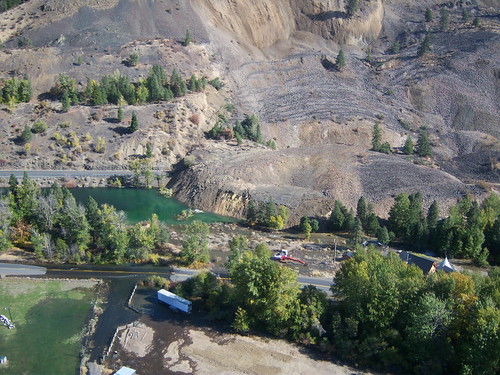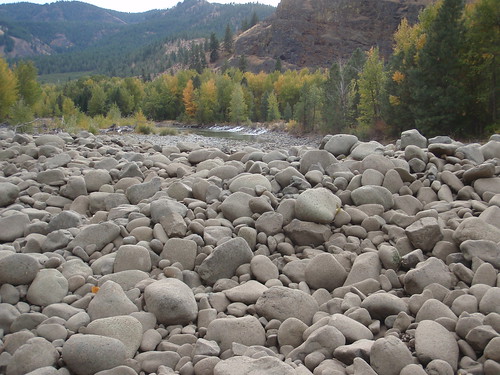Wednesday, October 28, 2009
SR 410 Nile Valley Landslide (west of Naches)

SR 410 Nile Valley Landslide (west of Naches), originally uploaded by Washington State Dept of Transportation.
An excellent view of the landslide...nicely done.
SR 410 Nile Valley Landslide (west of Naches)

SR 410 Nile Valley Landslide (west of Naches), originally uploaded by Washington State Dept of Transportation.
Check out the great photoset of the recent landslide near Naches, Washington.
http://www.flickr.com/photos/wsdot/sets/72157622438776353/
Saturday, October 24, 2009
Impressive lava-river interaction in Argentina
GEOMORPHIC HISTORY OF RIVERS DRAINING THE EASTERN ANDEAN CORDILLERA (34–37°S) CONSTRAINED BY TEPHROCHRONOLOGY, U-SERIES DATING OF PEDOGENIC CARBONATE AND COSMOGENIC 3HE DATING OF BASALT FLOWS
HYNEK, Scott A., Geology and Geophysics, University of Utah, 115 S 1460 E, Salt Lake City, UT 84112-0119, scott.hynek@utah.edu, MARCHETTI, David W., Geology Program, Western State College of Colorado, 600 N. Adams St, Gunnison, CO 81231, FERNANDEZ, Diego P., Geology and Geophysics, University of Utah, 115 S. 1460 E. Rm 383, Salt Lake City, UT 84112, and CERLING, Thure E., Department of Geology and Geophysics, University of Utah, Salt Lake City, UT 84112Alluvial deposits and associated geomorphic features are dated by their relation with volcanic rocks. The age range and geologic setting requires a broad approach to constraining the history of rivers draining the Cordillera. Maximum age estimates are provided by identification of the ~ 450 ka Diamante Tuff in fill terraces. Along the Río Diamante this ash bed is observed >100 m above modern river level. In the Río Papagayos and Río Atuel drainages, the Diamante Tuff is associated with alluvial surfaces much closer to modern river level. Coarse Diamante pumice in the Río Atuel implies significant changes to the headwater drainage system since 450 ka. The maximum age constraint implied by occurrence of the Diamante Tuff in fill terraces has been successfully combined with minimum age estimates from cosmogenic 10Be approaching 350 ka (Baker et al., 2009). The relatively old age of alluvial surfaces in the region is additionally supported by U-series age estimates derived from pedogenic carbonate in volcanic soils. A minimum age in excess of 100 ka is conservative. The dated surface is underlain by a pumice/lapilli tephra deposit and basalt flows both of which have the potential to provide maximum age estimates for the surface. Conversely, the U-series data implies that the basaltic volcanism is older than 100 ka. Our age estimates of flows in several drainages are much younger. Cosmogenic 3He concentrations in hornblende from basaltic-andesites erupted along the Río Salado indicate exposure, and therefore eruption, ages younger than ~ 6 ka. These flows temporarily dammed the Río Salado in one location and bedrock incision below the level of the flows has occurred since. 3He concentrations in olivine from basaltic rocks at northeastern Volcán Payún Matru indicate a shield-building phase at ~ 40 ka. Recent basaltic aa flows from multiple vents are morphologically quite young and 3He exposure ages are forthcoming for one of them. The Río Grande has incised the older flows, and provides an average incision rate over a full glacial cycle. Combination of geochronological data from the region indicates provides accurate, if not tightly constrained, ages for alluvial surfaces and identifies spatially variable geomorphic rates influenced, in part, by contemporaneous volcanism.Lava v. River example from British Columbia

Kathy C. turned me on to this example yesterday. I had no idea. Lava flow is only about 250 yrs old. It is in the Stikine Volcanic Field. There is a related, somewhat brief, paper:
Thursday, October 22, 2009
Submerged tree in Clear Lake, Oregon
Wednesday, October 21, 2009
Friday, October 16, 2009
Owyhee lava and river profile figure...draft
Finally devised a way to confidently and easily extract profile data from the LiDAR data set in GlobalMapper. Surface profiles are simple. Basal profiles shown here are estimates based on some point measurements. Will vastly improve the basal profiles when GSA is over. Needed this figure, however, so spent too much time devising the method.
Wednesday, October 14, 2009
Nice renditions of the Owyhee River area map
Preparing for my GSA lava talk and came up with these new versions of
the map of the Owyhee River study area. The second one is just the lava.
The lava flow-landslide link laid bare

This one supports the tenet:
'Intracanyon lava flows, the gifts that keep on giving'.
A garishly colored map that underscores the tight linkage betweenlandslides and lava flows on the Owyhee. If it is not the margin of
the lava flow that is failing, then it is the canyon wall that the
lava flow forced the river against that is failing (or both).
Certainly a tight coupling in this reach, no?
Two pleasing renditions of the map
the map. The second one is just the lava.
Bogus Rim Lava / Iron Point Dam
Monday, October 12, 2009
West Crater and Saddle Butte lava faceoff at Ryegrass Creek
This upstream-looking 3-D block rendition of the Ryegrass Creek area on the Owyhee is intriguing. The color ramp works well here because the strata are flat-lying. Note the boulder-covered and very flat surface below the Qbsy and above Ryegrass Creek...I suspect it relates to the pre-Saddle Butte lava Owyhee or Ryegrass Ck channel in some way, but I have never actually stood on it. Also, look at the morphology of the eastern edge of the Qbsy where the lacustrine seds sit...distinct linear trace there was map as fault by Ferns et al., but isn't it just the contact between the paleovalley wall and the lava? What about that abrupt wall in the Qbsy flow just beyond there? Looks like it is heading down a narrow valley.
Thursday, October 8, 2009
Some intriguing LiDAR-based block models from the Owyhee
Thursday, October 1, 2009
State of the Owyhee Map: 10/01/09
2. Unit descriptions need to be written up using Cooper's thesis as a base. This part will require input from all principal members of the research team
3. Accompanying text to the map. This will be a detailed accounting of the geologic history implied / required by the geologic map.
4. Send the whole package out for review. Likely, we will do this through DOGAMI who have agreed to publish the map if we can cover most / all of the costs. Now, back to the lower Walker River map due in 15 days.




















